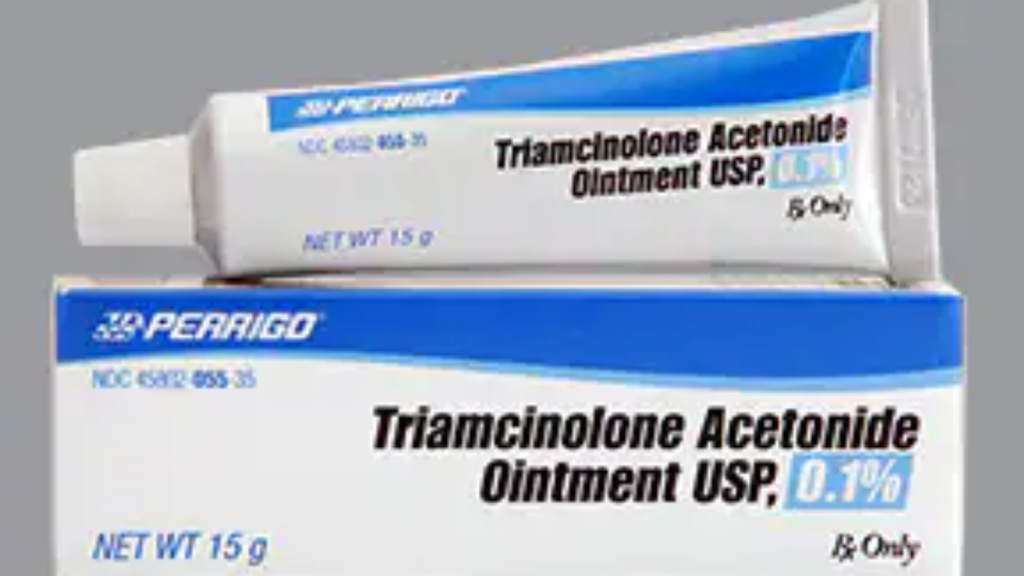Triamcinolone Acetonide Topical Side Effects Uses & More All you need to know
Triamcinolone acetonide belongs to a class of drugs called topical corticosteroids. It is used in the treatment of corticosteroid-responsive dermatoses, such as psoriasis and eczema. It relieves their symptoms such as itching, swelling, and redness.
The different topical forms of the medicine are:
- Cream
- Lotion
- Ointment
It is considered a prescription medication and cannot be bought without a doctor’s prescription. This topical corticosteroid has medium to strong potency, depending on the strength and form of the medication you are prescribed.
The initial application of triamcinolone acetonide topical may cause your skin to itch, burn, irritate, or become dry. These side effects should fade away after a few days. If they do not disappear or increase in intensity, consult your doctor immediately.
For skin conditions such as psoriasis, occlusive dressing is advised by doctors. A nonporous film covers the lesion after the application of this topical corticosteroid.
Do not give it to anyone else who is suffering from the same condition as you are.
In this article, we will talk about the triamcinolone acetonide topical’s mechanism of action, and the skin diseases it treats. We will also mention the side effects experienced by its application and the contraindications.

Generic name: Triamcinolone acetonide
Common brand names:
- Kenalog
- Cinolar
- Triderm
How does triamcinolone acetonide topical work?
Triamcinolone acetonide topical works through three different mechanisms of action.
Anti-inflammatory action:
Steroids are hormones that are released by the adrenal glands naturally whenever the body is under stress or suffering from a disease or trauma. This hormone works by binding to the nuclei of the cells and in turn causes it to release a protein called “Lipocortin”.
These proteins play a role by blocking a chemical important for inflammation, arachidonic acid, which results in lesser inflammation. Since triamcinolone acetonide is a corticosteroid, it works in the same way.
Immunosuppressive action:
The immune system is responsible for fighting off infections using different types of immune cells by neutralizing foreign bodies like viruses and bacteria.
By doing so, these cells may release some toxic chemicals that damage the normal cells of the body and further intensify the ongoing inflammation.
Triamcinolone acetonide hinders this reaction and helps reduce tissue damage that may ensue because of inflammation
Vasoconstrictive action:
Inflammation causes the blood vessels to dilate around the infected or wounded area. This is the reason why an infected or wounded site may look red and swollen and feel warm.
This drug works by constricting vessels especially capillaries and in turn reducing the localized swelling and pain.
Clinical indications of triamcinolone acetonide topical
The two conditions treated by triamcinolone acetonide topical are:
Psoriasis
Psoriasis is an autoimmune skin condition in which the cells of the skin multiply and accumulate, causing scaling to appear on the surface. This scaling is surrounded by redness and inflammation.
Triamcinolone acetonide helps to relieve this redness and inflammation.
Eczema
Eczema is a group of skin conditions in which the skin becomes itchy, dried, inflamed, and swollen. When this condition is treated with this topical corticosteroid, there is a reduction in the itchiness, swelling, and redness of the skin.
Besides these two conditions, triamcinolone acetonide is also used in the treatment of:
- Mouth sores
- Dermatitis
- Rash
Dosage of triamcinolone acetonide topical
There are different strengths and formulations of this medicine. These strengths and formulations determine the potency of the drug.
It is available as a cream, lotion, and ointment.
Triamcinolone acetonide topical lotion is available in the dosages:
- 0.025%
- 0.1%
Triamcinolone acetonide topical ointment is available in the dosages:
- 0.025%
- 0.05%
- 0.1%
- 0.5%
Triamcinolone acetonide topical cream is available in the dosages:
- 0.025%
- 0.1%
- 0.5%
Dosage of Triamcinolone acetonide cream
0.025% cream applied 2 to 4 times in a day. 0.1% or 0.5 % cream can also be applied 2 to 3 times in a day.
Dosage of Triamcinolone acetonide lotion
0.025% lotion applied 2 to 4 times in a day. 0.1% lotion can also be applied 2 to 3 times in a day.
Dosage of Triamcinolone acetonide ointment
0.025% ointment applied 2 to 4 times in a day. 0.1% ointment can also be applied 2 to 3 times in a day.
Carefully follow your doctor’s instructions. Do not stop using the medicine unless you are advised by your doctor. Using it for more than the period specified for treatment is not recommended.
If you forget a dose, apply it as soon as you remember it. If the time for the next dose is almost near, you can skip the missed dose. Do not make up for the missed dose by taking a double dose.
Route of administration
Triamcinolone acetonide cream, lotion, and ointment are applied topically. Do not use it on your face, underarms, and groin without the consultation of your doctor.
When you apply it to the affected area of the skin, rub it gently. Ensure that you have washed your hands before and after the application. Do not use it on healthy skin or large areas.
Getting the medicine in your eyes can cause glaucoma or it can worsen already present glaucoma. Therefore, be careful while applying it near the eyes.
If the medicine gets into your eyes, wash them with plenty of water.
Occlusive dressing
If you are suffering from recalcitrant conditions, such as psoriasis, occlusive dressing can help in their management. Do not do it unless your doctor advises it.
After applying the medicine to the lesion, gently rub it until it disappears into the skin. Reapply it again and form a thin coating over the lesion. Use a pliable nonporous film, covering the lesion with it, and seal the edges.
For moisture, you can damp clean cotton cloth and cover the lesion with it before the application of the film. You can also add moisture to the lesion by wetting it with water before you apply the medicine to it.
You can do the occlusive dressing in the evening and remove it in the morning. During the day, keep applying for the medicine without the dressing.
In case you develop an infection in the affected area, you should not continue occlusive dressing. The infection should be treated with antimicrobials.
Side effects of triamcinolone acetonide topical
The side effects of triamcinolone acetonide topical are:
- Burning, itching, irritation, or dryness of skin
- Folliculitis (inflammation of hair follicles)
- Hypertrichosis (abnormal hair growth)
- Acneiform eruptions (acne-like eruptions)
- Hypopigmentation
- Perioral dermatitis (red rash around mouth)
- Allergic contact dermatitis (allergic reaction of the skin to allergens)
- Skin maceration (soggy or wrinkled skin)
- Secondary infection
- Atrophy of skin (thinning of the skin)
- Striae (stretch marks)
- Miliaria (heat rash)
These side effects are not as frequent, but they become frequent if the occlusive dressing is included in the treatment.
Using it for an extended period or improper application can lead to the following side effects:
- Nausea
- Diarrhea
- Depression
- Increased blood pressure
- Appetite loss
- Skin bruising
- Skin softening
- Swollen feet or legs
- Bloating of stomach
- Increased thirst
- Increased urination
- Mouth dryness
- Unusual tiredness
- Weakness of muscles
- Muscle cramps
- Mood changes
- Blurred vision
- Loss of vision
- Pain in eye
- Weight gain in body areas such as the face, torso, or upper back
- Slow wound healing
- Menstrual changes
- Sexual changes
Most of these side effects are due to the absorption of corticosteroids into the body from the skin. Children are most likely to suffer from these side effects.
There are some side effects you may develop that are not mentioned in this article. Talk to your doctor about them.
Contraindications of triamcinolone acetonide topical
Triamcinolone acetonide topical should not be used if:
- You are allergic to triamcinolone
- You are suffering from skin tuberculosis
- You have a skin infection by a virus, such as herpes simplex, varicella, and vaccinia
If you have infected skin lesions by fungi or bacteria that have not been treated, you cannot take triamcinolone acetonide alone. You are supposed to take antifungal or antibacterial medication along with it.
Drug interactions
Triamcinolone acetonide topical may interact with other topical drugs having corticosteroids in them. This can lead to exacerbation of side effects. Therefore, it is important to talk to your doctor about any topical drug you are using.
Your doctor may ask you to stop one of the drugs or they may give you an alternative medication if there is a risk of severe side effects. If it is safe to use other topical drugs with triamcinolone acetonide, you can continue using them.
Besides the topical drugs, you also need to mention to your doctor if you are taking other prescription drugs, over-the-counter drugs, herbal medicines, and supplements.
Overdosage
You are not likely to overdose on triamcinolone acetonide as it is topically administered. Still, you should not exceed the amount prescribed by the doctor. In case you or someone you know accidentally swallow it, you should seek immediate medical care.
Storage
While storing it, make sure that:
- It is kept at room temperature (15-30 degrees Celsius or 59–86 degrees Fahrenheit)
- No moisture, heat, and direct sunlight is in touch with it
- It is kept in a place where children cannot reach it



